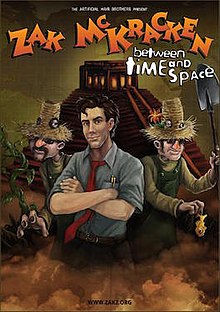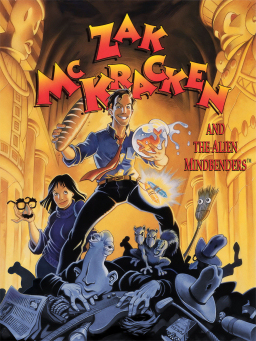
Zak McKracken and the Alien Mindbenders is a 1988 graphic adventure game by Lucasfilm Games. It was the second game to use the SCUMM engine, after Maniac Mansion. The project was led by David Fox, with Matthew Alan Kane as the co-designer and co-programmer.
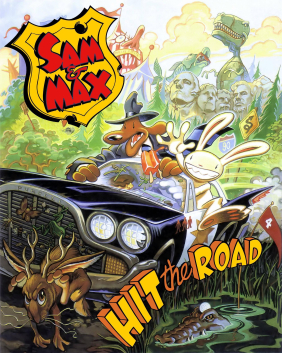
Sam & Max Hit the Road is a graphic adventure video game released by LucasArts during the company's adventure games era. The game was originally released for MS-DOS in 1993 and for Mac OS in 1995. A 2002 re-release included compatibility with Windows. The game is based on the comic characters of Sam and Max, the "Freelance Police", an anthropomorphic dog and "hyperkinetic rabbity thing". The characters, created by Steve Purcell, originally debuted in a 1987 comic book series. Based on the 1989 Sam & Max comic On the Road, the duo take the case of a missing bigfoot from a nearby carnival, traveling to many American culture tourist sites to solve the mystery.
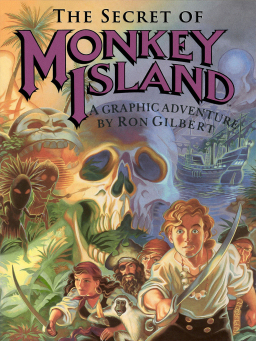
The Secret of Monkey Island is a 1990 point-and-click graphic adventure game developed and published by Lucasfilm Games. It takes place in a fictional version of the Caribbean during the age of piracy. The player assumes the role of Guybrush Threepwood, a young man who dreams of becoming a pirate, and explores fictional islands while solving puzzles.

Revolution Software Limited is a British video game developer based in York, founded in 1989 by Charles Cecil, Tony Warriner, David Sykes and Noirin Carmody. Its most popular line of games is that of Broken Sword, a series which began in 1996 with Broken Sword: The Shadow of the Templars. As of 2024, there have been a further four iterations in the series: The Smoking Mirror (1997), The Sleeping Dragon (2003), The Angel of Death (2006) and The Serpent's Curse (2013).
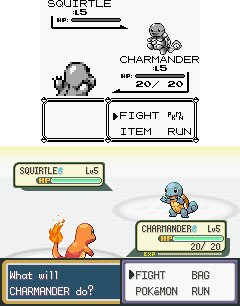
A video game remake is a video game closely adapted from an earlier title, usually for the purpose of modernizing a game with updated graphics for newer hardware and gameplay for contemporary audiences. Typically, a remake of such game software shares essentially the same title, fundamental gameplay concepts, and core story elements of the original game, although some aspects of the original game may have been changed for the remake.

From the late 1980s to the early 2000s, LucasArts was well known for their point-and-click graphic adventure games, nearly all of which received high scoring reviews at the time of their release. Their style tended towards the humorous, often irreverent or slapstick humor, with the exceptions of Loom and The Dig. Their game design philosophy was that the player should never die or reach a complete dead-end, although there were exceptions.
Broken Sword is a series of adventure games. The first game in the series, Broken Sword: The Shadow of the Templars, was released and developed in 1996 by British developer Revolution Software. Its sequel, Broken Sword II: The Smoking Mirror, was released a year later, and was followed by Broken Sword: The Sleeping Dragon in 2003, Broken Sword: The Angel of Death in 2006, and Broken Sword 5: The Serpent's Curse in 2013. A remake of the first game in the series, known as Broken Sword: Shadow of the Templars – The Director's Cut, was released in 2009, and a remake of the second game in the series, Broken Sword: The Smoking Mirror – Remastered, in 2010 for iOS devices; other platforms followed in 2011.
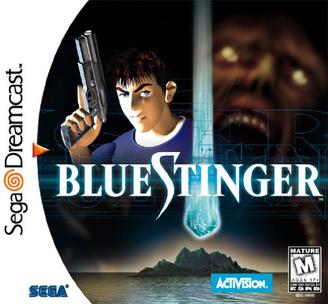
Blue Stinger is a 1999 action-adventure game developed by Climax Graphics for the Dreamcast. It was published by Sega in Japan, and by Activision in Western territories as a console launch title. The story follows emergency rescuer Eliot Ballade after he is stranded on the monster-infested Dinosaur Island and allies with fellow survivors and the alien being Nephilim to find the source of the monsters. Gameplay has Eliot navigating Dinosaur Island, fighting monsters using various weapons found or purchased during the game, and finding items to progress to other areas.

Beetle Adventure Racing! is a racing game released for the Nintendo 64 in 1999. It was developed by Paradigm Entertainment and EA Canada, and published by Electronic Arts. Each vehicle in the game is a Volkswagen New Beetle, which was released the previous year. The gameplay involves racing other players on unlocked tracks, finding and destroying crates, and collecting colored ladybugs while battling other players. The single-player championship offers three circuits and a secret bonus circuit with new vehicles and tracks available upon completion.
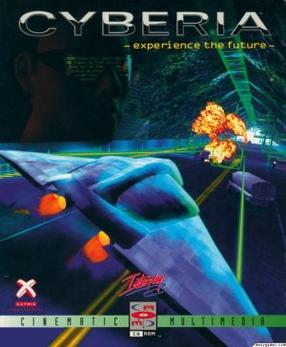
Cyberia is a science fiction action adventure video game released for MS-DOS in January 1994, and released two years later on the PlayStation, Sega Saturn, 3DO and FM Towns consoles. A sequel, Cyberia 2: Resurrection, was released in 1995 for both DOS and Windows 9x formats.

Plan 9 from Outer Space is a point and click adventure game adaptation of the film of the same name. It was developed at the Irish office of Gremlin Graphics for the Amiga and Atari ST, and was released in 1992. The game was published by Gremlin in Europe and by Konami in the United States. A DOS version was also developed, though only released in the US and Europe. Two editions of the game were made available at retail; the more common version was packaged with a VHS copy of the film, while a rarer version contained only the game.

Space Quest III: The Pirates of Pestulon is a 1989 graphic adventure game by Sierra On-Line, and the third game in the Space Quest series. Players assume the role of Roger Wilco, a lowly space janitor, who becomes involved in rescuing a pair of computer programmers from a sinister video game company. The game received positive reviews from critics, and contributed further to the series' commercial success for Sierra. A sequel, Space Quest IV, was released in 1991.
Dave Gilbert is an American designer of independent adventure games using Adventure Game Studio. He began creating home-made, freeware games, and went professional in 2006, founding Wadjet Eye Games and releasing commercially The Shivah and The Blackwell Legacy.

Metal Slader Glory is an adventure game developed and published by HAL Laboratory for the Famicom in 1991. The game is set in 2062 after humans have colonized the Moon and established several space stations. Earth-based mechanic Tadashi and his girlfriend discover a mech from a war eight years past with an ominous message stored in its memory suggesting Earth is in danger. Tadashi decides to venture to nearby space colonies along with Elina and his younger sister Azusa to investigate the origins of the mech. As Tadashi, the player speaks with other characters and picks dialogue and action commands to advance the narrative.

Sonic Unleashed is a 2008 platform game developed by Sonic Team and published by Sega as part of the Sonic the Hedgehog series. The plot follows Sonic as he attempts to restore the world after his nemesis Doctor Eggman shatters it with a powerful laser to unleash Dark Gaia, an ancient evil which periodically transforms Sonic into a werewolf form. Gameplay features two distinct styles: daytime stages incorporate Sonic's traditional platforming and trademark speed; while night-time stages see Sonic transform into the Werehog and engage in slower combat against waves of enemies using the Werehog's brute strength.
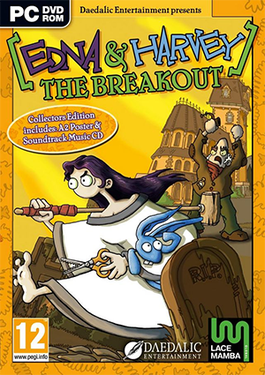
Edna & Harvey: The Breakout is a 2008 German adventure video game developed by Daedalic Entertainment. The game was originally released for Microsoft Windows, macOS and iOS. An anniversary edition was released in 2019 and 2020 for Microsoft Windows, macOS, SteamOS + Linux, Nintendo Switch, PlayStation 4, Xbox One and Amazon Luna. Starring a young woman and her toy rabbit, the objective of the game is to escape from a mental hospital in which they find themselves in at the beginning of the game.

Black Forest Games GmbH is a German video game developer based in Offenburg. The company was founded in July 2012 by a team of 40 staff members, including chief executive officer Andreas Speer, previously employed by Spellbound Entertainment, which filed for insolvency earlier that year. As of August 2017, it is a subsidiary of THQ Nordic. As of August 2024, the company employs 50 people.

Ghost in the Sheet is a 2007 first-person point-and-click adventure game developed by Cardboard Box Entertainment and released in Germany as S.C.A.R.E.
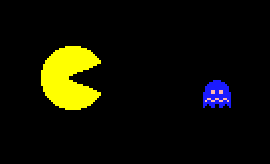
A cutscene or event scene is a sequence in a video game that is not interactive, interrupting the gameplay. Such scenes are used to show conversations between characters, set the mood, reward the player, introduce newer models and gameplay elements, show the effects of a player's actions, create emotional connections, improve pacing or foreshadow future events.

Alien Odyssey is an action-adventure game developed by Argonaut Software and published by Philips Media in 1995. The game features a mixture of first-person and third-person gameplay, with sequences involving shooter, adventure and puzzle mechanics. Alien Odyssey makes use of 3D rendering and full motion video cutscenes which were developed using the developer's proprietary B-Render graphics software. Upon release, the game received a mixed reception, with reviewers praising the visual presentation of the game, whilst critiquing the game's inconsistent mixture of game modes and short length.
